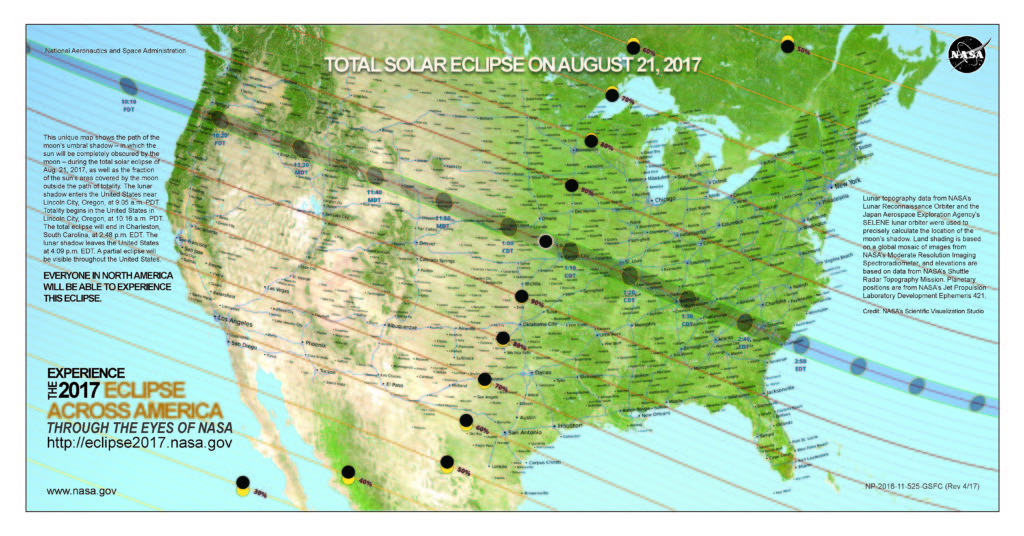You've probably heard by now that on Monday, August 21, a total solar eclipse (officially dubbed the Great American Eclipse) will progress its ways across the United States, all the way from Oregon to South Carolina, leaving hunting areas across 12 states immersed in total darkness for almost three minutes. It's a hot topic, considering a phenomenon like this hasn't occurred in the United States since 1979. In fact, a total solar eclipse hasn't swept the nation since June 8, 1918.
So, how will this rare celestial event affect wild game and the hunters who pursue those animals?
First, what is a total solar eclipse?
Beginning around 10 a.m. PDT on Oregon's Pacific coastline, the eclipse will traverse across the U.S. and continue on that path over the next several hours. It is predicted to reach South Carolina by 3 p.m. EDT.
At some point during its journey, a shadow of the moon resulting from it blocking the sun's rays will pass over parts of the country including Salem, Oregon; Lincoln, Nebraska; Jefferson City, Missouri; Nashville, Tennessee; Augusta, Georgia; and Columbia, South Carolina. This is called the path of totality, and people are traveling from far and wide to experience it firsthand.
Click here for maps and more in-depth information on the path of the eclipse.
How will the animals react?
Big-game hunters know that the moon and its phases have a profound effect on how animals move, feed and breed. And during a total eclipse, the sky goes dark and air temperatures drop. But how will wild game react to the moon blocking out the sun?
The truth is that no one knows for certain, and with only a handful of hunting seasons currently open and with totality expected to only last two minutes and 40 seconds, we may not find out this time around.
However, according to a statement on NASA's website, “It has been reported during many eclipses that many different animals are startled by totality and change their behavior thinking that twilight has arrived."
During a total eclipse, it becomes intensely dark — darker than it is at night because the sunlight the moon normally reflects won’t reach Earth. Air temperatures can drop 20 degrees. However, if the weather is good, it should be the perfect day to be outdoors.
Here are some ways animals are likely to respond to totality:
- Cows and other livestock may return to the barn early.
- Deer will become restless and may bed down prematurely. And they could remain in their bedding areas into the evening. Plan to be along routes leading to known bedding areas.
- Squirrels will shift into hyperactivity, and will be visible around nut-bearing trees for several hours after the eclipse ends. This foraging behavior may last for days.
- Whales and dolphins have been known to breach the water, putting on quite a display.
- Birds will stop singing and flock to roost areas.
What does this mean for hunters?
If you're a hunter, it may be worth ducking out of work and heading afield on August 21 to experience this rare opportunity. Some can even get in a morning hunt before the daytime darkness falls. Pronghorn antelope hunters can legally hunt parts of Idaho, New Mexico, Oregon and Wyoming; black-tailed deer hunters will be hunting in parts of California; cow elk hunters can hunt in parts of Oregon; even white-tailed deer hunters can hunt private lands in South Carolina this time of year.
However, it's important to note that the eclipse's totality will be brief, so if you're out in the field, sit back and observe this incredible natural phenomenon. The next one won’t affect North America until 2024. Or, better yet, record what you observe. Hunters are tailor made for one of the citizen-scientist programs designed for recording wildlife behaviors during the eclipse.
The National Audubon Society features two such programs on its website. The free iNaturalist app introduced a special feature called Life Responds. It lets users log wildlife sightings 30 minutes before, 5 minutes during and 30 minutes after the eclipse. Those who track information should focus on change in vocalizations and movement. There's other things to look for too. Do birds scatter? Or even, does a flower fold its petals?
Another program, the Eclipse Soundscapes Project, is focused solely on capturing audio. Contributors can use any smartphone app or handheld recorder of their choice to capture sounds, starting half an hour before the eclipse and lasting until half an hour after. To learn how and where to share your audio files, go here.
How you should prepare for the total solar eclipse
For more information on how to prepare for the Great American Eclipse, click here. The most important thing is to be safe. Stay aware of your surroundings — both human and animal alike — and protect your eyes while viewing the partially eclipsed sun through special-purpose solar filters, such as eclipse glasses or hand-held solar viewers. You can find more safety tips from NASA here.
If you're looking for somewhere to view the eclipse, there are more than a dozen U.S. wildlife refuges in prime viewing areas. You can check the list out here and get more information on what access is available to viewers on August 21.
If you do make it out during the eclipse and witness something crazy — especially if you’re in the path of totality — let us know! You can find us on Facebook here, or email me at ahoward@grandviewmedia.com. We’d love to experience it through your eyes.
Featured photo: NASA







